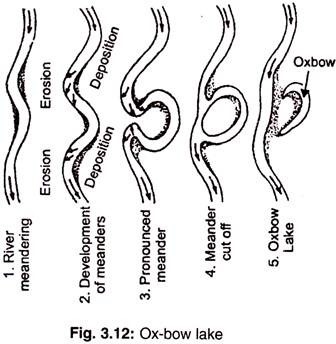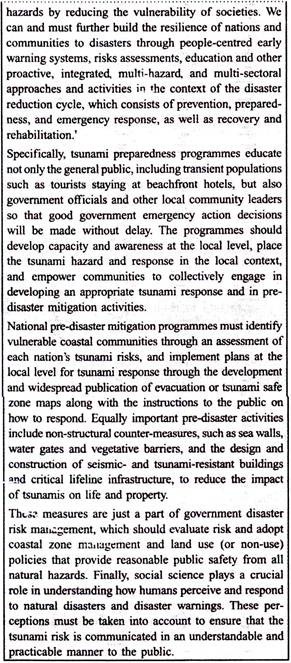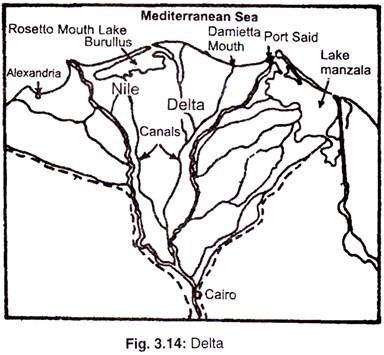ADVERTISEMENTS:
After reading this essay you will learn about:- 1. Definition of Infiltration 2. Factors Affecting Infiltration 3. Measurement 4. Estimation.
Essay on Infiltration
Essay Contents:
- Essay on the Definition of Infiltration
- Essay on the Factors Affecting Infiltration
- Essay on the Measurement of Infiltration
- Essay on the Estimation of Infiltration
Essay # 1. Definition of Infiltration:
ADVERTISEMENTS:
Infiltration may be defined as entry and movement of water through the land surface into the sub strata. When rainwater falls on the ground, there is some resistance offered by the soil surface for the entry of rainwater and also to the flow of water through the soil.
There are cracks, vertical as well as lateral in the soil, so also there are some voids between the soil particles, which are ordinarily occupied by air or water. Water flows through these cracks and gaps until it reaches the saturated zone below. Naturally the passage of water experiences some resistance.
The rate at which water enters the ground surface and then flows downwards is known as infiltration rate. This rate is high in the beginning because it has to meet the requirements of the dry soil. However, it attains a steady constant constant lower value after passage of time.
Essay # 2.
Factors Affecting Infiltration:
The factors affecting infiltration are discussed below:
ADVERTISEMENTS:
(i) Rainfall Characteristics:
The duration as well as the intensity of rainfall influences infiltration. If the intensity of rainfall is more than the infiltration rate, then only surface runoff is noticed. On the contrary, if the intensity of rainfall is less than the infiltration rate, no surface flow is observed and all the rainfall is abstracted as infiltration.
The rate of infiltration is high in the beginning and goes on reducing and attains a steady state after some time. At earlier stage the intensity of rainfall may be less than the rate of infiltration. Under this condition, the ground will absorb all the rainfall and there will not be any surface flow.
ADVERTISEMENTS:
However, when the infiltration rate reduces and becomes less than the intensity of precipitation, surface flow will be noticed, which might increase till the infiltration rate stabilizes.
In addition to this consideration rainfall has some additional effects as follows:
i. When rainwater strikes the bare soil, there is mechanical compaction of soil due to the impact, which may reduce the infiltration rate.
ii. Fine soil particles are carried down due to rain water resulting in choking of the pore spaces in the soil, and consequently resulting in reducing the infiltration rate.
(ii) Ground Surface Condition:
The land surface that received rain may be bare, vegetated or covered with mulch or litter. The bare ground receiving rainfall may be subjected to the effects of impact, and so on. If impervious material is exposed at the surface, naturally infiltration is small or negligible.
The vegetated ground reduces the impact effect of the raindrops, avoids dislodging of particles by mechanical binding action of the roots and hence provides a high rate of infiltration by maintaining open soil structure and also slows down the rate of runoff. Thus, due to vegetated ground the rate infiltration increases.
Mulch cover has got a similar effect. Because of mulch and litter, the infiltration rate increases. This has been proved by the field experiment. Contour plugging and terracing in the agricultural land delays the surface flow and increases the infiltration rate.
Small surface slope has little effect on the infiltration rate. If the slope of the ground is steeper than 16°, then the rate of infiltration reduces due to the velocity of water causing more overland flow.
(iii) Soil Characteristics:
Soil characteristics have definite effect on infiltration.
ADVERTISEMENTS:
A uniformly graded material will have more pores and hence the infiltration rate will be more than a well-graded material. In clayey soils, because of the removal of moisture due to evaporation, some shrinkage cracks may be observed. These are termed as Sun cracks. Because of these cracks, infiltration rate may increase in the initial stage. Subsequently, when the soil gets wet, the cracks gets closed and may not affect the infiltration rate.
Because of the presence of water, some soil have a tendency to form aggregation that reduces the infiltration rate. Also, the organic material present helps to promote soil aggregation. In some cases, puddle is formed at the surface where the soil has a fair proportion of clay, which becomes relatively impervious when it dries.
In the case of urbanization because of concrete buildings, asphalt pavement, and so on, the infiltration rate is considerably reduced.
(iv) Soil Moisture:
Even if the soil contains some moisture, there is no effect, practically on the rate of infiltration except that the rate is reduced at the initial stage, as shown in Fig. 1.14.
(v) Human Activities:
Cultivation of land disturbs the soil structure, closes the openings made by burrowing animals and insects as well as decaying roots and thus reduces the rate of infiltration.
(vi) Climatic Conditions:
The flow of water through the soil is laminar. Change in temperature may cause change in the viscosity of water and consequently may cause change to the velocity of water, and thus may affect the rate of infiltration.
(vii) Entrapped Air:
If infiltration process covers a large area, there may not be an exit passage to the entrapped air in the soil. Also, because of the downward passage of water, the air entrapped may get compressed and may offer more resistance to the flow, which may result in reducing the infiltration rate.
(viii) Other Minor Factors:
Other factor, such as depth of water on the ground, groundwater table, and so on, have practically no effect on the infiltration rate.
Essay # 3.
Measurement of Infiltration:
The rate of infiltration is initially high. It goes on reducing with time and after some time it becomes steady. A usual graph of the rate of infiltration is shown in Fig. 1.14. The rate of infiltration for a soil is measured in the field as well as in the laboratory. These are known as infiltrometers.
The most common types are the following:
i. Flooding type infiltrometers
ii. Sprinkling type infilitrometers or rain, simulators.
A. Flooding Type Infiltrometers:
There are two types of flooding-type infiltrometers:
a. Single-tube flooding infiltrometer.
b. Double-tube flooding infiltrometer.
a. Single-Tube Flooding Infiltrometer:
The single-tube flooding infiltrometer consists of a metal tube 250-300 mm in diameter with both ends open. This tube is driven in a vertical position into an open level ground surface up to depth of 500 mm, leaving about 100 mm above the ground. The tube is so driven into the ground that the soil is disturbed to a minimum.
Water is then added to this tube to maintain a constant level, sufficiently deep to submerge the plant or the grass crowns. If the soil is bare, i.e., there is no vegetation grass, the soil is protected by a perforated metal disc to avoid turbidity.
A pointer gauge is used to measure the water level accurately. As the infiltration starts, the water level may drop down but it is maintained at a constant level by adding a measured quantity of water at successive time intervals, till a constant rate of infiltration is achieved.
Knowing the quantity of water added, the time interval and the area of tube, the rate of infiltration can be worked out. The infiltration rate thus worked out is more than the actual value.
Fig. 1.15 shows a single-tube infiltrometer. It is also known as single-ring infiltrometer.
b. Double-Tube Flooding Infiltrometer:
In the case of a single-tube infiltrometer, water may flow sideways. Such loss is controlled to some extent by using one more ring outside the test ring. Instead of one tube, two concentric circular tube are used. These may be of size 300 and 600 mm in diameter. These are driven 150 mm in the ground in a vertical position leaving 100 mm above the ground level. The outside metal ring is used to avoid the side and border effects.
The procedure followed for single tube is followed in this double-tube case also water is added into both the tubes and the same level of water is maintained in both tubes by adding the measured quantity of water at successive time intervals.
The observation for the inner tube are used for working out the infiltration rate. Knowing the water added, the time interval and the area of cross-section of the inner tube, the infiltration rate with respect to time can be calculated.
Figure 1.16 shows a double ring infiltrometer. It is also known as double- ring infiltrometer.
Drawback in Tube Infiltrometers:
The main drawbacks in the tube infiltrometers are as follows:
i. The soil disturbed to some extent when the tubes are driven into the soil.
ii. There may be lateral flow of infiltrated water. In double-tube infiltrometers, efforts are made to reduce it, but some lateral flow still occurs.
iii. Similarly, air entrapped in the soil may escape laterally. In a double-tube infiltrometer, this effect persists.
iv. Effect of the raindrop impact on soil is not accounted.
v. Effect of the slope of ground is not accounted.
vi. Experiments cannot be conducted on soil with boulders etc.
vii. The infiltration is affected because of the ring size. Smaller the diameter of the ring, more will be the rate of infiltration.
B. Sprinkling Type Infiltrometer:
This experiment is conducted in the laboratory under controlled condition.
For this purpose, a very small catchment area, about 5 m2, is selected. Water is sprinkled over the catchment area to represent rainfall at a uniform rate of about 50 mm/hr. Sprinkling of water may be from a height of 5 m. The trial starts with the sprinklings of water. It is, therefore, called sprinkling type infiltrometer. Sprinkling of water represents rain, and hence it is also called rain simulator.
The surface runoff is measured very accurately at the catchment outlet and thus knowing all the abstractions such as ‘evaporation, interception, depression storage, surface detention’ and surface runoff, the infiltration rate during the time of experiment can be worked out.
Consider the following particulars of specific experiment as shown in Fig. 1.17:
The experiment started at 8:00 a.m. by sprinkling water over the entire catchment area at a uniform rate, which was stopped at 12:00 noon. There was no surface runoff noticed up to 8:30 a.m. The discharge was noticed at 8:30 a.m. and it went on increasing up to 10:00 a.m. and remained constant up to 12:00 noon. When the sprinkling of water, i.e. rainfall, was stopped, the discharge went on reducing and finally stopped at 2:00 p.m. as shown in Fig. 1.18.
The rainfall P may be accounted for as follows:
P = E + I + Ds + F + SD + Q
Where, P = Precipitation at a uniform rat a uniform rate over the entire catchment in mm/hr
E = Evaporation in mm/h
I = Interception in mm/h
Ds = Depression storage in mm/h
F = Infiltration in mm/h
SD = Surface detention (water stored temporarily in channel)
Q = Surface runoff in m3/s converted to mm/h over the catchment area
Thus, F = P – (E + I + D + SD + Q)
(All these quantities are measured in mm uniformly spread over the entire catchment area.)
The parameters in the bracket were calculated separately, combined together and then subtracted from the precipitation and thus the infiltration rate was calculated. Infiltration started immediately at 8:00 a.m.
The following assumptions were made:
1. Evaporation being negligible during the experiment was neglected.
2. As usual, interception and depression storage were combined together and treated as SR surface retention. This abstraction started immediately at 8:00 a.m.
The precipitation was started at 8:00 a.m. and stopped at 12:00 noon. The precipitation graph with respect to time and its mass curve is shown in Fig. 1.19.
A judgement was taken as to how much water was lost as surface retention, and its requirement would be first met with completely form 8:00 a.m. to 8.30 a.m. and there would be no addition in this abstraction after 8:30 a.m. Surface runoff started only after the requirement of the surface retention was met with. The surface retention and its mass curve is shown in Fig. 1.20.
The discharge was observed from 8:30 a.m. onwards. It went on increasing up to 10:00 a.m. It was constant from 10:00 a.m. to 12:00 noon and then reduced from 12:00 noon to 2:00 p.m. The discharge as well as its mass curve is shown in Fig. 1.21.
The SD is in mm/s, i.e. water stored in the channel is a function of depth in a channel. More the discharge in the channel more will be the depth in the channel and more will be the storage in the channel. Thus, indirectly SD will be a function of discharge. Here the discharge was started at 8.30 a.m. Similarly, SD also started at 8:30 a.m. It went on increasing up to 10.00 a.m. It remained constant from 10:00 a.m. to 12:00 noon and then was reduced from 12:00 noon to 2:00 p.m.
Since initially and also after the experiment the channel carried no water, the water in the channel from 8:30 a.m. was drained completely from 12:00 noon to 2:00 p.m.
When the precipitation stopped at 12:00 a.m. there was still flow in the stream. This was due to draining to water stored in the channel, i.e., SD. Immediately after the precipitation stopped in the channel was the area under the recession curve. As the discharge reduced, so also did the storage in the channel. The storage in the channel will be the area under the recession curve. The recession curve is shown in Fig. 1.22.
The area under the recession curve is the total channel storage.
A = A1 + A2 + A3
When the discharge is Q1, the channel storage SD is A1.
When the discharge is Q2, the channel storage SD is A1 + A2.
When the discharge is Q3, the channel storage SD is A1+ A2 + A3 which is the area under the recession curve.
Thus, the relation between Q and SD can be established as shown in Fig. 1.23.
SD can be calculated from this graph and then correlated with time. SD thus calculated will be in terms of m3 and will have to be worked out in terms of mm over the entire catchment area for further calculation. The surface detention and its mass curve are shown in Fig. 1.24.
A combined mass curve of (SR + Q + SD) and mass curve of P is plotted on the graph paper and the difference between these two mass curves is the infiltration rate w.r.t. time.
From this figure, the infiltration rate w.r.t time can be plotted.
Drawbacks in Sprinkling Type Infiltrometer:
The main drawbacks in the sprinkling-type infiltrometer are as follows:
i. It is very difficult to have a uniform sprinkling of water of a uniform intensity over the entire catchment area for a sufficient duration.
ii. The discharge has to be measured very accurately.
iii. The assumption of SR requires good judgement.
iv. The area under the experiment being small, lateral flow may be significant.
Essay # 4.
Estimation of Infiltration:
The rate at which water infiltrates into a ground is called the infiltration capacity. When a soil is dry, the infiltration rate is usually high compared to when the soil is moist. For an initially dry soil subjected to rain, the infiltration capacity curve shows an exponentially decaying trend as shown in Fig. 1.25. The observed trend is due to the fact that when the soil is initially dry, the rate of infiltration is high but soon decreases, as most of the soil gets moist. The rate of infiltration reaches a uniform rate after some time.
Interestingly, if the supply of continuous water from the surface is cutoff, then the infiltration capacity starts rising from the point of discontinuity as shown in Fig. 1.26 below.
For consistency in hydrological calculations, a constant value of infiltration rate for the entire storm duration is adopted.
The average infiltration rate is called the Infiltration index and the two types of indices commonly used are explained below:
Infiltration Indices:
The two commonly used infiltration indices are the following:
1. ϕ-Index.
2. W-Index.
1. The ϕ – Index:
This is defined as the rate of infiltration above which the rainfall volume equals runoff volume, as shown in Fig. 1.27.
The method to determine the ф -index would usually involve some trial. Since the infiltration capacity decreases with a prolonged storm, the use of an average loss rate in the form of W-index is best suited for design storms occurring on wet soils in which case the loss rate reaches a final constant rate prior to or early in the storm.
Although the W-index is sometimes criticized as being too simple a measure for infiltration, the concept is quite meaningful in the study of storm runoff from large watersheds. The evaluation of the infiltration process is less precise for large watersheds. The data is never sufficient to derive an infiltration curve. Under the circumstances, the W-index is the only feasible alternative to predict the infiltration from the storm.
2. The W-Index:
This is the average infiltration rate during the time when the rainfall intensity exceeds the infiltration rate.
Thus, W may be mathematically calculated by dividing the total infiltration (expressed as a depth of water) divided by the time during which the rainfall intensity exceeds the infiltration rate.
Total infiltration may be fund out as under:
Total Infiltration = Total Precipitation-Surface Runoff – Effective Storm Retention
The W=index can be derived from the observed rainfall and runoff data. It differs from the index in that it excludes surface storage and retention. The index does not have any real physical significance when computed for a multiple complex watershed. Like the phi-index the index, too is usually used for large watersheds.














